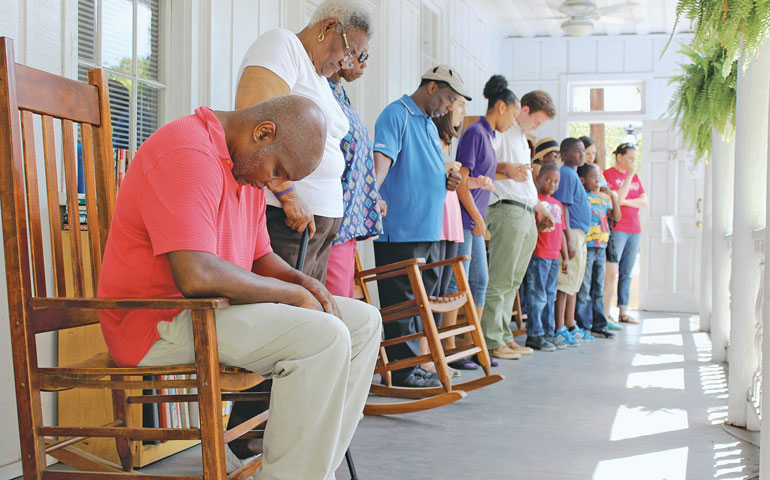
Members of the Manna Life Center lead an ecumenical prayer service June 19 in Charleston, S.C., at the Neighborhood House, which is part of Our Lady of Mercy Community Outreach Center. They prayed for the victims of the shootings at Emanuel African Methodist Episcopal Church, and the children who lost their parents. (CNS/The Catholic Miscellany/Victoria Wain)
Pope Francis develops the key theme of “integral ecology” in his encyclical “Laudato Si’, on Care for Our Common Home.” Integral ecology links the largest theological themes of the Catholic tradition -- that we are all intimately one in God’s being -- with the nitty-gritty of loving our neighbor and caring for the smallest and most vulnerable creatures.
God lures us into a dance with each and every one of us together with the whole of creation. We all share one life, one Earth. One cannot and will not thrive unless all thrive in the interdependent web of life.
And yet, in the wake of the brutal murder of nine members of the Emanuel African Methodist Episcopal Church in Charleston, S.C., do we perceive the intimate connections between care for the whole of creation and black lives?
Our African-American brothers and sisters can’t breathe (Eric Garner), can’t eat skittles or wear a hoodie (Trayvon Martin), can’t play loud music (Jordan Davis), can’t play as a child in a park (Tamir Rice), can’t seek help after an accident (Renisha McBride), can’t walk to a store with a friend (Rekia Boyd), and can’t pray in their own church (Cynthia Hurd, the Rev. Clementa Pinckney, Sharonda Coleman-Singleton, Tywanza Sanders, Ethel Lee Lance, Susie Jackson, the Rev. DePayne Middleton-Doctor, the Rev. Daniel Lee Simmons and Myra Thompson).
As Claudia Rankine in The New York Times said a black mother told her, “The condition of black life is one of mourning.” That is perpetual mourning. If predominantly white churches value black lives, we would share in that mourning, not in passing, but as brothers and sisters bound by an integral life in Christ.
Pinckney and eight members of his congregation at Emanuel AME Church welcomed Dylann Roof as one of their own. Two things about the witness of these nine church members haunt theologian Willie James Jennings. First, Jennings is haunted by the fact that Roof was present “in the intimate space of that bible study, sitting there at a table with these saints of God who were seeking to hear a holy word just for them, just for this moment. I would feel less pain if he would have simply walked into church and started shooting; then I could live with the fact that this young man did not … give God’s voice the chance to penetrate his contorted heart.”
The problem is that Roof “did hear the sound of grace and communion. God’s voice was sounding in Emmanuel. He simply resisted it.”
Jennings further elucidates how Roof “showed us the deaf ear of those seeking whiteness, a deafness that reaches deep into the soul and thwarts the power of God’s love.”
Second, Jennings is haunted by the forgiveness that the families of the victims offered Roof. He cites the granddaughter of the Rev. Daniel Lee Simmons, Alana Simmons, who said, “We are here to combat hate-filled actions with love-filled actions.”
Jennings struggles to understand how black folks are called upon throughout the centuries “in tortuous repetition to forgive those who kill us, and we do it. The only way I can fathom this grace of forgiveness is if the very life of God flows through people like these black families.”
Yet Jennings struggles with the way forgiveness is interpreted. Too often, it is used to avoid dealing with whiteness and the “state of war” it creates in America. Forgiveness can be a “soothing high” that does not address the lie that is white supremacy.
White Christians ought to be haunted, too. Now and too many times in the past, white people disassociate ourselves from the depth of connection we have with white people who foment racial terror.
We ought not dismiss Roof as a lunatic. Yet we do. As we disassociate ourselves from this American son and the way he was malformed, we lose the opportunity to examine our own malformation and the conversion to which we are called in this kairotic moment.
This is a kairos moment, when Pope Francis and the #BlackLivesMatter movement call us to personal and cultural transformation.
If we are going to take up the cultural transformation the pope invites, it will mean confronting how white supremacy is a form of “tyrannical anthropocentrism” that divides us from one another and the Earth. By “tyrannical anthropocentrism,” Francis means every “irresponsible domination of human beings over other creatures.”
The Atlantic slave trade initiated a tyrannical anthropocentrism, in which whiteness equates with innocence and blackness with savagery. The slave trade deified ownership of both people and land. W.E.B. Du Bois captured that deification when he wrote: “Whiteness is the ownership of the earth forever and ever, Amen!”
The disproportionate negative impacts of environmental degradation on communities of color exposes, as theologian Shawnee M. Daniels-Sykes explains, the overlapping interconnections between environmental racism and lack of care for black lives lost to gun violence.
Do we hear the cries of the earth and of our brothers and sisters at the Emanuel AME Church? Their cries evoke God’s cry, ever groaning with the whole of creation for loving embrace and justice.
[Alex Mikulich is co-author of The Scandal of White Complicity in U.S. Hyper-Incarceration: A Nonviolent Spirituality of White Resistance.]



